All wired up -- the shoe edition
When I was still active on the Knitlist, sometimes I would start my infrequent but long winded messages to the list with a mea culpa for not posting in so long. So same as it ever was.
I've work deadlines this week but trying to squeeze in a bit more blogging before the only writing I'm doing is about databases, C++, XML etc.
I've been looking at the queue of photos and such that have been waiting to make the jump from web page to blog and trying to decide which will jump first. Recently I asked for prototypes of mini-pointe shoes to come home and found myself digging into my wire stash. When I combine that activity with the blistering my toes have insisted on making a serial event the obvious choice was shoes and wire.
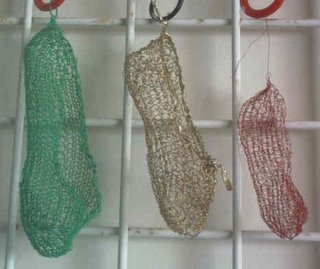
When I first got interested in knitting with wire I thought that it would be perfect for lace. It isn't. Lucy Neatby's knitted wire earrings gave me and others the false impression that wire and lace knitting were a good mix. In fact, the only way Lucy could get that level of control was to knit everything at the very tips of the needles and for me at least, that's just way too much like work for far too little pay off.
Knitting with wire is not for control freaks unless you want to either be quite obsessive or learn to let go and let the material do what it will. Me? I'm pretty much a let the thing be what it will be kind of person so once I figured out that knitting with wire was not going to go the way I'd thought I made adjustments and let the material guide my course.
Anyhow, I got interested in knitting with wire back in 1998 or thereabouts mostly because of the Lucy's knitted earrings. And when the Stitches West 1999 brochure included a Nancie Wiseman class on knitting with wire I was even more interested. Unfortunately, a lot of other people were also interested and even knowing Nancie didn't get me into the class that year.
Just before Stitches West 2000, Ornament magazine had an article on Arlene Fisch's wire knitting and the San Diego Historical Society had an exhibit of her work. As is my want, I consciously avoided both the article and the exhibit until after I had taken the class and found my own feel for working with wire. I did go to the exhibit afterward and I could tell that her work, while fabulous was much more the work of a metalworker mimicking textiles making the the forms less organic than my efforts.
It was in that class that I discovered just how frustrated some people were with the wire not doing what they wanted it to. I confess that I a lot of the knitted wire stuff I've seen doesn't do anything for me but I still like working with wire and different types of wires.
Unless you have a strong tolerance for sounds that are like nails on a chalkboard, use wooden needles when knitting with wire. Yes, the wire will tend to discolour the needles bit but no more than working with yarn with a fast dye. You also need to take the time to block as you go which is to say, coax the wire away from the needle as you knit. If you don't you will really struggle to get the needle into the stitches.
 The first major experiment was a pointe shoe knit on 28 gauge copper wire on 3mm needles for the 2000 Dance As Ever Great Knitter's Auction and Raffle.
The first major experiment was a pointe shoe knit on 28 gauge copper wire on 3mm needles for the 2000 Dance As Ever Great Knitter's Auction and Raffle.
It took me three weeks to design and test the shoe but only three hours to knit.
I was so taken with the work that I actually ended up in a bidding war for the silly thing and still think that if Leigh hadn't directed people elsewhere I would have lost the war and not had it come home to me.

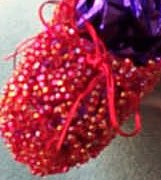 In a later auction I went a bit mad and did the same basic design but with 32 gauge wire, size 11 red beads and 2.5 mm needles. It actually took longer to thread the beads than it did to knit the piece. Indeed, it had started as a birthday present for Leigh but took so long that it ended up being an auction piece instead.
In a later auction I went a bit mad and did the same basic design but with 32 gauge wire, size 11 red beads and 2.5 mm needles. It actually took longer to thread the beads than it did to knit the piece. Indeed, it had started as a birthday present for Leigh but took so long that it ended up being an auction piece instead.
It wasn't a terribly successful auction piece when the time factor was considered. Still, as things turned out, it did become a birthday present so even though it didn't do as well at auction as its sibling it all came right in the end. The photos that Mary LoSardo took for the actual auction are much better than the ones I took, and since she kindly emailed them to me, I'll take the liberty using them here.
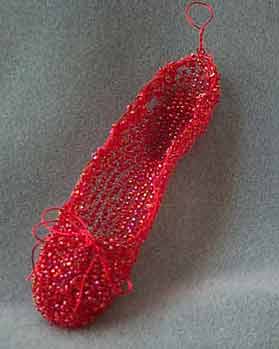
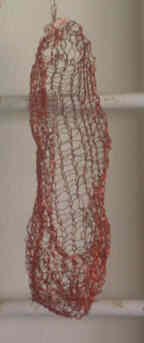 The prototype for this shoe was knit with 32 gauge wire without the beads. It was so fine that I felt it needed to be reinforced with thread or something . At that gauge, copper wire, tends to get a bit brittle and crimps up very easily -- if it crimps on itself it tends to break so crimping is something to be avoided. This shoe is only 4" long from heel to toe where the original gold copper wire is 6"
The prototype for this shoe was knit with 32 gauge wire without the beads. It was so fine that I felt it needed to be reinforced with thread or something . At that gauge, copper wire, tends to get a bit brittle and crimps up very easily -- if it crimps on itself it tends to break so crimping is something to be avoided. This shoe is only 4" long from heel to toe where the original gold copper wire is 6"
I'm not exactly sure when I got the mad idea to work with kynar wire. I suspect that I was casting about looking for wire that came in a lot of colours and didn't have the problem of losing colour from the knitting that the clad copper wire can have.
I know I'd already experimented with plain floral wire, fabric coated floral wire and a few other types of wire before the kynar stuff got my attention. I also remember that my original swatch of the stuff had me thinking that it would hold a shape more reliably than the copper (I was thinking about a blue wire knitted dreidel) and might even actually be good for actually doing lace with wire because the stitches formed look more like knitting and less like just a grid. The wire dreidel notion was a bust but I did combine some green kynar to 3mm needles and, following the same recipe as the original gold copper wire shoe produced this pointe shoe. It is 7" from heel to toe and it is wider than its siblings even with the same number of stitches.
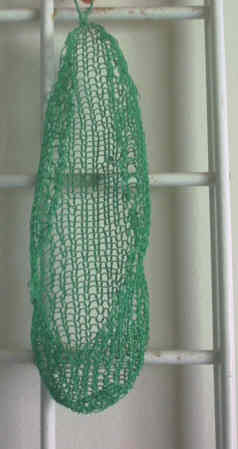
I've work deadlines this week but trying to squeeze in a bit more blogging before the only writing I'm doing is about databases, C++, XML etc.
I've been looking at the queue of photos and such that have been waiting to make the jump from web page to blog and trying to decide which will jump first. Recently I asked for prototypes of mini-pointe shoes to come home and found myself digging into my wire stash. When I combine that activity with the blistering my toes have insisted on making a serial event the obvious choice was shoes and wire.

When I first got interested in knitting with wire I thought that it would be perfect for lace. It isn't. Lucy Neatby's knitted wire earrings gave me and others the false impression that wire and lace knitting were a good mix. In fact, the only way Lucy could get that level of control was to knit everything at the very tips of the needles and for me at least, that's just way too much like work for far too little pay off.
Knitting with wire is not for control freaks unless you want to either be quite obsessive or learn to let go and let the material do what it will. Me? I'm pretty much a let the thing be what it will be kind of person so once I figured out that knitting with wire was not going to go the way I'd thought I made adjustments and let the material guide my course.
Anyhow, I got interested in knitting with wire back in 1998 or thereabouts mostly because of the Lucy's knitted earrings. And when the Stitches West 1999 brochure included a Nancie Wiseman class on knitting with wire I was even more interested. Unfortunately, a lot of other people were also interested and even knowing Nancie didn't get me into the class that year.
Just before Stitches West 2000, Ornament magazine had an article on Arlene Fisch's wire knitting and the San Diego Historical Society had an exhibit of her work. As is my want, I consciously avoided both the article and the exhibit until after I had taken the class and found my own feel for working with wire. I did go to the exhibit afterward and I could tell that her work, while fabulous was much more the work of a metalworker mimicking textiles making the the forms less organic than my efforts.
It was in that class that I discovered just how frustrated some people were with the wire not doing what they wanted it to. I confess that I a lot of the knitted wire stuff I've seen doesn't do anything for me but I still like working with wire and different types of wires.
Unless you have a strong tolerance for sounds that are like nails on a chalkboard, use wooden needles when knitting with wire. Yes, the wire will tend to discolour the needles bit but no more than working with yarn with a fast dye. You also need to take the time to block as you go which is to say, coax the wire away from the needle as you knit. If you don't you will really struggle to get the needle into the stitches.
 The first major experiment was a pointe shoe knit on 28 gauge copper wire on 3mm needles for the 2000 Dance As Ever Great Knitter's Auction and Raffle.
The first major experiment was a pointe shoe knit on 28 gauge copper wire on 3mm needles for the 2000 Dance As Ever Great Knitter's Auction and Raffle.It took me three weeks to design and test the shoe but only three hours to knit.
I was so taken with the work that I actually ended up in a bidding war for the silly thing and still think that if Leigh hadn't directed people elsewhere I would have lost the war and not had it come home to me.

 In a later auction I went a bit mad and did the same basic design but with 32 gauge wire, size 11 red beads and 2.5 mm needles. It actually took longer to thread the beads than it did to knit the piece. Indeed, it had started as a birthday present for Leigh but took so long that it ended up being an auction piece instead.
In a later auction I went a bit mad and did the same basic design but with 32 gauge wire, size 11 red beads and 2.5 mm needles. It actually took longer to thread the beads than it did to knit the piece. Indeed, it had started as a birthday present for Leigh but took so long that it ended up being an auction piece instead.It wasn't a terribly successful auction piece when the time factor was considered. Still, as things turned out, it did become a birthday present so even though it didn't do as well at auction as its sibling it all came right in the end. The photos that Mary LoSardo took for the actual auction are much better than the ones I took, and since she kindly emailed them to me, I'll take the liberty using them here.

 The prototype for this shoe was knit with 32 gauge wire without the beads. It was so fine that I felt it needed to be reinforced with thread or something . At that gauge, copper wire, tends to get a bit brittle and crimps up very easily -- if it crimps on itself it tends to break so crimping is something to be avoided. This shoe is only 4" long from heel to toe where the original gold copper wire is 6"
The prototype for this shoe was knit with 32 gauge wire without the beads. It was so fine that I felt it needed to be reinforced with thread or something . At that gauge, copper wire, tends to get a bit brittle and crimps up very easily -- if it crimps on itself it tends to break so crimping is something to be avoided. This shoe is only 4" long from heel to toe where the original gold copper wire is 6"I'm not exactly sure when I got the mad idea to work with kynar wire. I suspect that I was casting about looking for wire that came in a lot of colours and didn't have the problem of losing colour from the knitting that the clad copper wire can have.
I know I'd already experimented with plain floral wire, fabric coated floral wire and a few other types of wire before the kynar stuff got my attention. I also remember that my original swatch of the stuff had me thinking that it would hold a shape more reliably than the copper (I was thinking about a blue wire knitted dreidel) and might even actually be good for actually doing lace with wire because the stitches formed look more like knitting and less like just a grid. The wire dreidel notion was a bust but I did combine some green kynar to 3mm needles and, following the same recipe as the original gold copper wire shoe produced this pointe shoe. It is 7" from heel to toe and it is wider than its siblings even with the same number of stitches.

0 Comments:
Post a Comment
Subscribe to Post Comments [Atom]
<< Home